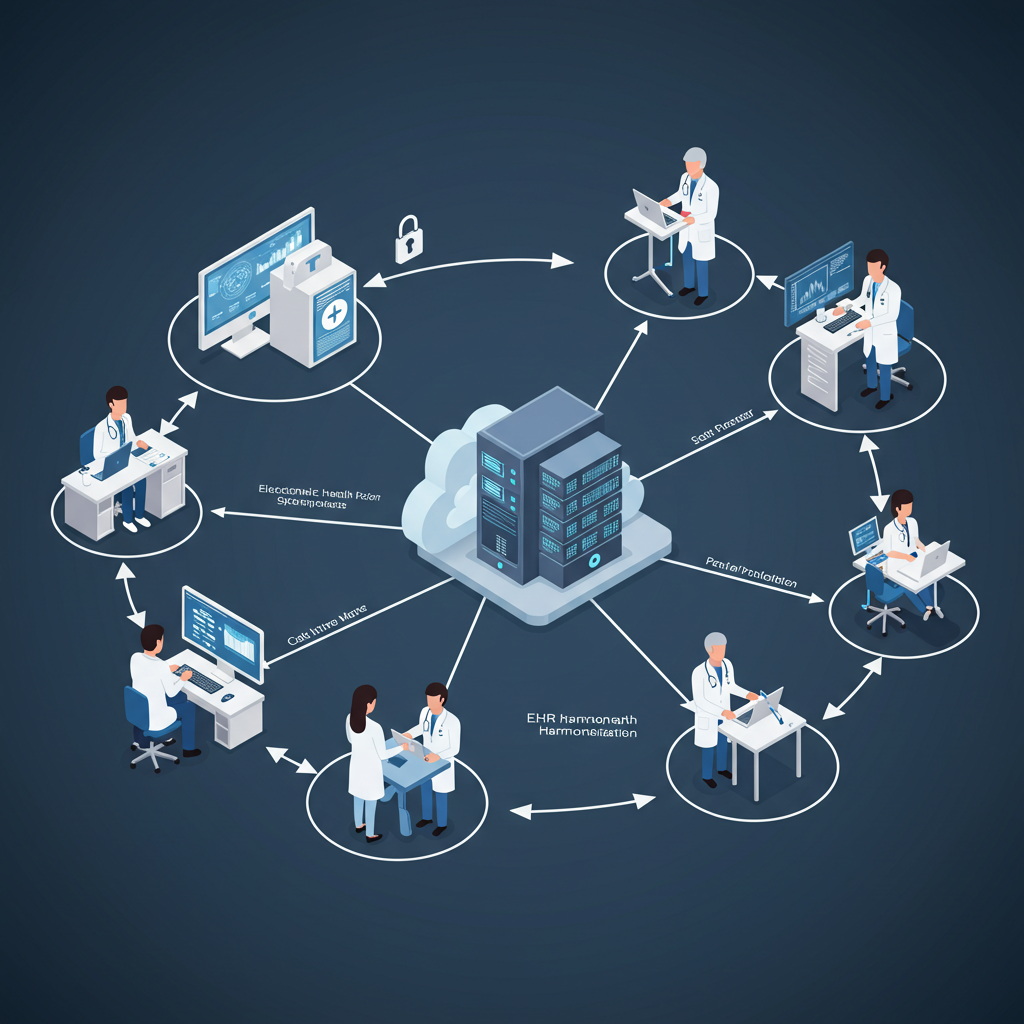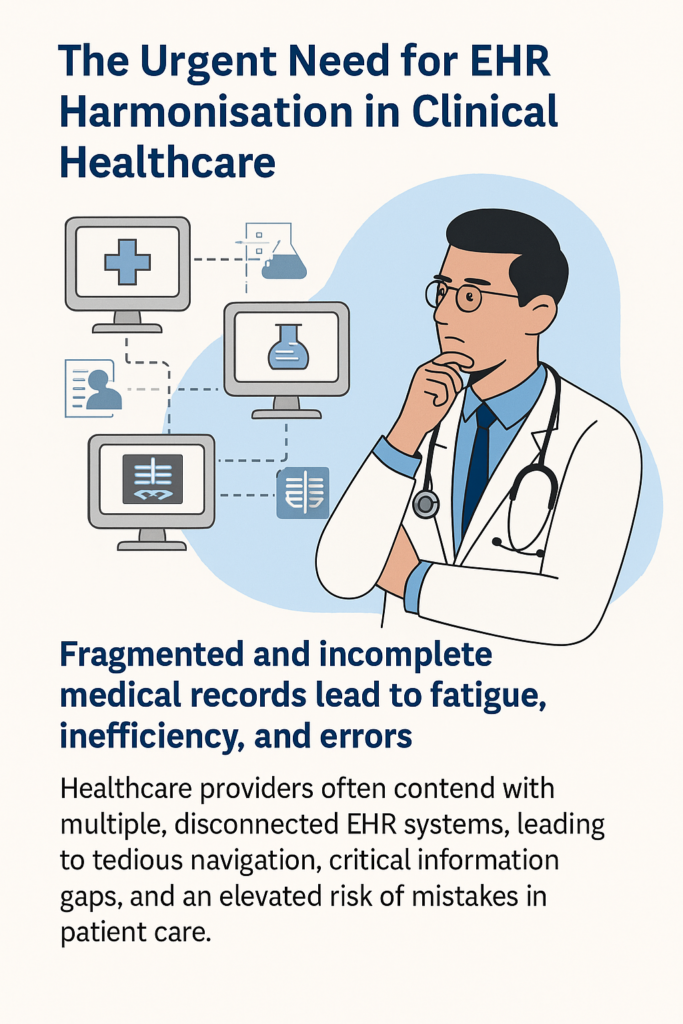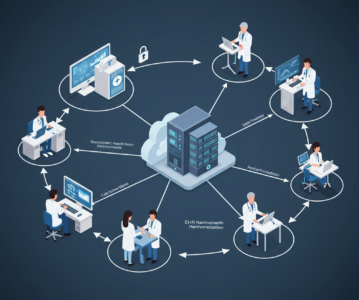The Urgent Need for EMR Harmonisation in Clinical Healthcare

In today’s healthcare environment, digital information is everywhere. Each patient interaction—whether it’s a consultation, lab test, scan, or prescription—adds to a growing record of data. However, instead of helping doctors, this information often ends up scattered across many different systems.
Clinicians commonly use separate software platforms depending on the task. One system may manage Emergency Department records, while another handles ward admissions. A third might be used for ordering tests, and yet another for viewing scans. Meanwhile, a patient’s medical history, allergy records, and long-term medications may sit in a completely different database.
This fragmentation causes serious problems. Doctors must constantly switch between systems. They need to learn different layouts, remember multiple passwords, and search through scattered information. All of this wastes time and energy, especially in urgent situations. Most importantly, it can lead to errors. That’s why healthcare systems urgently need EHR harmonisation—a way to standardise and connect data across platforms.
What Is EHR Harmonisation?
EHR harmonisation means making sure that all electronic health records follow the same structure, language, and standards. With harmonisation, data becomes easier to understand and share, no matter which system a hospital or clinic uses. It doesn’t just allow systems to talk to each other—it helps them understand the information they’re sharing in the same way.
Why Is It So Important?
1. Fragmentation Wears Down Clinicians
Doctors often use one system to admit a patient, another to order blood tests, and a different one to check scan results. Each switch demands time and attention. Over time, this overload creates what’s known as decision fatigue—mental exhaustion caused by repeated, complex choices in a disorganised workflow.
As a result, care slows down. Critical details may get missed. For instance, a penicillin allergy might only appear in one system. If a doctor doesn’t open that specific file, they might unknowingly prescribe a harmful drug.

2. Disconnected Data Causes Errors
When systems don’t follow the same rules, important information can get lost or misunderstood. A high potassium level might raise an alert in one system, but not in another. Medication lists often vary between inpatient and outpatient platforms, increasing the risk of duplicated or incorrect prescriptions.
Transfers between departments highlight this issue. When patients move from the ED to the ward, doctors might receive only partial information. That forces them to chase missing details or repeat tests. As a result, turnaround time—the time between a clinical decision and action—increases.
3. Systems Must Work Together
True interoperability depends on harmonisation. Different software tools must not only exchange data, but also understand it in the same way. For example, one system might use “MI” to mean “Myocardial Infarction,” while another sees it as “Mitral Insufficiency.” Without standardised medical codes like SNOMED CT or LOINC, this confusion continues.
How Harmonisation Helps Clinicians
1. Clearer, Safer Clinical Decisions
Harmonised records give doctors access to complete, accurate patient information at the right time. That improves clinical judgment, especially in high-stress environments like emergency departments or intensive care units.
Instead of guessing or double-checking, clinicians can trust what they see. They can create treatment plans with confidence, knowing they have the full picture—medical history, test results, current medications, and more—all in one place.
2. Smoother Workflows
Manual data entry, repeat tests, and tracking down missing results all waste time. Harmonisation makes things easier. It allows for auto-filled forms, smart alerts, and smoother documentation.
This saves energy. It also cuts down on transcription mistakes and unnecessary tests. Doctors spend less time fighting with systems and more time treating patients.
3. Better Data for Smarter Tools
Clean, standardised data helps unlock the full potential of health technology. Hospitals can study patterns in disease, treatment results, and resource use across large groups of patients. AI tools and decision support systems work better when they use reliable, harmonised data.
For example, early warning systems for sepsis or readmission risk need accurate and consistent inputs. With harmonised EHRs, these tools become more useful and more trusted.
4. Easier, Stronger Research
Modern research often relies on data from multiple hospitals. Without harmonisation, combining that information takes weeks or months. Researchers must clean and adjust mismatched data before they can study it.
Harmonised EHRs solve this problem. They allow researchers to compare results across different sites and run larger, faster studies. Clinical trials also benefit, since standard data can help identify suitable participants more efficiently.
What Happens If We Don’t Change?
If we keep using disconnected systems, healthcare will remain inefficient and risky. Doctors will continue repeating work, and patients may suffer delays, missed diagnoses, or unsafe treatments. Meanwhile, new technologies like telemedicine and AI will struggle to function without clean, connected data.
In short, broken systems lead to broken care.
Time to Act
EHR harmonisation is no longer optional. It’s the key to safer, faster, and smarter healthcare. Clinicians gain freedom from system overload and mental fatigue. Patients benefit from better outcomes. Researchers unlock new insights. And health systems become more efficient and more innovative.
Healthcare already collects a vast amount of data. But to truly help patients, we need to connect that data—and connect it properly. Harmonisation builds the bridge between technology and better care. Now is the time to cross it.
